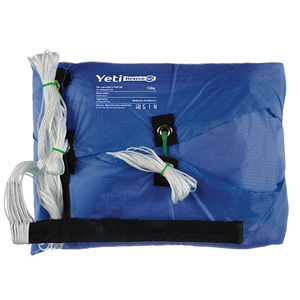
- Aircraft
- Aircraft
- Emergency parachute
- GIN Gliders
Rescue parachute G-lite
Add to favorites
Compare this product
fo_shop_gate_exact_title
Characteristics
- Applications
- rescue
- Wing surface
31 m², 38 m²
(333.7 ft², 409 ft²)- Maximum load
105 kg, 130 kg
(231 lb, 287 lb)- Weight
1.7 kg, 2.1 kg
(3.75 lb, 4.63 lb)
Description
The G-lite is an annular pulled-down apex rescue parachute for paraglider and paramotor pilots.
Developed by GIN, it’s an evolution of our One-G, one of the best-selling rescue parachutes of all time. Compared to the One-G, the G-Lite offers greater stability and a reduction in weight whilst remaining reliable and cost-effective.
Reduced weight
The G-Lite is significantly lighter than the comparable size of One-G. Due to improved gore shape generated by 3D design, we could reduce the rescue size without compromising safety and a sink rate.
Good sink rate and stability
The G-lite’s design offers excellent sink rate and stability. This has enabled us to both increase the maximum weight and reduce the surface area. The size 32 is certified to a maximum load of 105kg with a sink rate of 5.0m/s. Pilots flying below the maximum load will have a lower sink rate than this.
Bridle options
Rescue Bridle for harnesses with integrated bridles
Y bridle (125cm or 155cm) is optionally available for harnesses with no bridles
Certification
The G-Lite is certified EN and LTF to the EN 12491 and LTF 91⁄09 standards.
Catalogs
Catalog Gin
37 Pages
hs-gingo-airlite-4-manual-en
29 Pages
Related Searches
- Paragliding wing
- Racing paraglider
- Single place paragliding wing
- Parachute
- Performance paragliding wing
- Rescue parachute
- Single place parachute
- Sport parachute
- Paramotor wing
- Single place paramotor wing
- Sport paramotor wing
- Mountain paraglider
- Performance parachute
- Beginner paraglider
- Intermediate paramotor wing
- Cross parachute
- Beginner paramotor wing
- School paraglider
*Prices are pre-tax. They exclude delivery charges and customs duties and do not include additional charges for installation or activation options. Prices are indicative only and may vary by country, with changes to the cost of raw materials and exchange rates.






